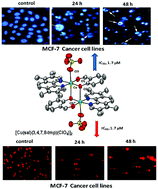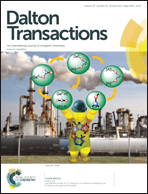Mixed ligand μ-phenoxo-bridged dinuclear copper(ii) complexes with diimine co-ligands: efficient chemical nuclease and protease activities and cytotoxicity†
Abstract
The water soluble mixed ligand copper(II) complexes of the type [Cu(sal)(diimine)(ClO4)]21–5, where sal is salicylaldehyde and diimine is 2,2′-bipyridine (bpy, 1), 1,10-phenanthroline (phen, 2), 5,6-dimethyl-1,10-phenanthroline (5,6-dmp, 3), 3,4,7,8-tetramethyl-1,10-phenanthroline (3,4,7,8-tmp, 4) or dipyrido[3,2-d:2′,3′-f]quinoxaline (dpq, 5), and [Cu(sal)(phen)(NO3)]2 (2a) have been successfully isolated and characterized by elemental analysis and other spectral techniques. The DNA binding and cleavage properties of 1–5 have been explored by using various physical and biochemical methods. The coordination geometry around copper(II) in the X-ray structures of 1, 2, 2a and 4 is described as an elongated octahedron. The UV-Vis and EPR spectral and ESI-MS studies reveal that in solution the dinuclear complexes dissociate into essentially mononuclear [Cu(sal)(diimine)]+ species with square-based geometry. The absorption spectral titrations and competitive DNA binding studies reveal that the intrinsic DNA binding affinity of the complexes depends upon the diimine co-ligand and is of the order of dpq (5) > 3,4,7,8-tmp (4) > 5,6-dmp (3) > phen (2) > bpy (1). The complexes 2 and 5 are involved in a partial intercalative interaction with DNA base pairs, while 3 and 4 are involved in a hydrophobic interaction with DNA and 1 is involved in an electrostatic interaction with DNA, which is supported by viscosity studies. Interestingly, only 3 and 4 are selective in exhibiting a positive induced CD band (ICD) upon binding to DNA suggesting that they induce a B to A conformational change in DNA. All the complexes exhibit an oxidative DNA cleavage ability, which varies as 5 > 4 > 3 > 2 > 1. While 4 and 5 are unique in displaying prominent double-strand DNA cleavage even in the absence of an activator, 2 and 3 display only single-strand DNA cleavage. Interestingly, all the complexes exhibit oxidative double-strand DNA cleavage in the presence of ascorbic acid, with 4 and 5 showing a DNA cleavage activity more prominent than 1 and 2. The ability of the complexes to bind and cleave the protein BSA varies in the order, 4 > 3 > 5 > 2 > 1. Interestingly, 3 and 4 cleave the protein in the presence of H2O2 as an activator in a non-specific manner suggesting that they can act as chemical proteases. It is remarkable that all the complexes exhibit cytotoxicity against human breast cancer cell lines (MCF-7) with a potency more than the widely used drug cisplatin indicating that they have the potential to act as effective anticancer drugs in a time dependent manner. The morphological assessment data obtained by using Hoechst 33258 staining reveal that 3 and 4 induce apoptosis much more effectively than the other complexes. Also, the alkaline single-cell gel electrophoresis study (comet assay) suggests that the same complexes induce DNA fragmentation more efficiently than others.


 Please wait while we load your content...
Please wait while we load your content...